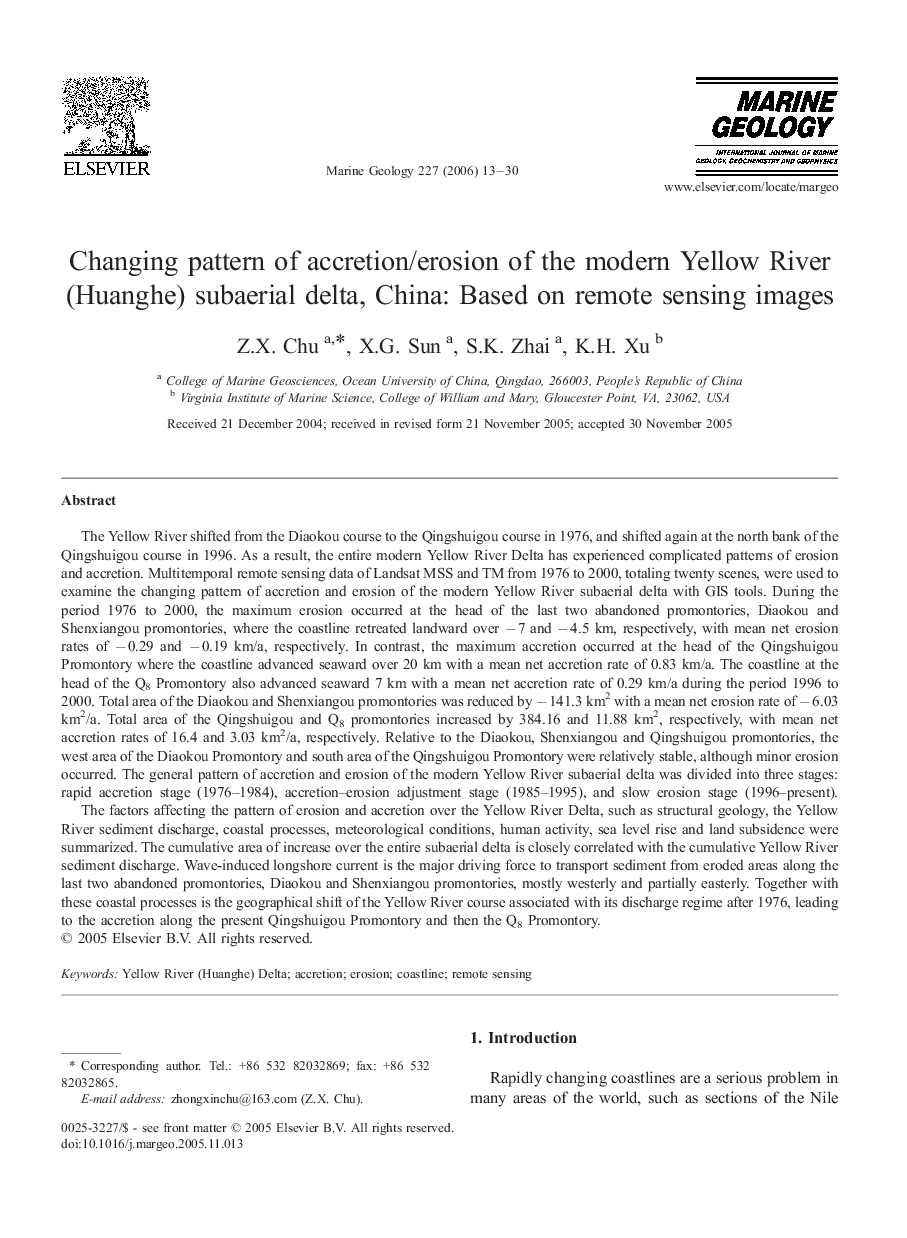| کد مقاله | کد نشریه | سال انتشار | مقاله انگلیسی | نسخه تمام متن |
|---|---|---|---|---|
| 4719848 | 1639215 | 2006 | 18 صفحه PDF | دانلود رایگان |

The Yellow River shifted from the Diaokou course to the Qingshuigou course in 1976, and shifted again at the north bank of the Qingshuigou course in 1996. As a result, the entire modern Yellow River Delta has experienced complicated patterns of erosion and accretion. Multitemporal remote sensing data of Landsat MSS and TM from 1976 to 2000, totaling twenty scenes, were used to examine the changing pattern of accretion and erosion of the modern Yellow River subaerial delta with GIS tools. During the period 1976 to 2000, the maximum erosion occurred at the head of the last two abandoned promontories, Diaokou and Shenxiangou promontories, where the coastline retreated landward over − 7 and − 4.5 km, respectively, with mean net erosion rates of − 0.29 and − 0.19 km/a, respectively. In contrast, the maximum accretion occurred at the head of the Qingshuigou Promontory where the coastline advanced seaward over 20 km with a mean net accretion rate of 0.83 km/a. The coastline at the head of the Q8 Promontory also advanced seaward 7 km with a mean net accretion rate of 0.29 km/a during the period 1996 to 2000. Total area of the Diaokou and Shenxiangou promontories was reduced by − 141.3 km2 with a mean net erosion rate of − 6.03 km2/a. Total area of the Qingshuigou and Q8 promontories increased by 384.16 and 11.88 km2, respectively, with mean net accretion rates of 16.4 and 3.03 km2/a, respectively. Relative to the Diaokou, Shenxiangou and Qingshuigou promontories, the west area of the Diaokou Promontory and south area of the Qingshuigou Promontory were relatively stable, although minor erosion occurred. The general pattern of accretion and erosion of the modern Yellow River subaerial delta was divided into three stages: rapid accretion stage (1976–1984), accretion–erosion adjustment stage (1985–1995), and slow erosion stage (1996–present).The factors affecting the pattern of erosion and accretion over the Yellow River Delta, such as structural geology, the Yellow River sediment discharge, coastal processes, meteorological conditions, human activity, sea level rise and land subsidence were summarized. The cumulative area of increase over the entire subaerial delta is closely correlated with the cumulative Yellow River sediment discharge. Wave-induced longshore current is the major driving force to transport sediment from eroded areas along the last two abandoned promontories, Diaokou and Shenxiangou promontories, mostly westerly and partially easterly. Together with these coastal processes is the geographical shift of the Yellow River course associated with its discharge regime after 1976, leading to the accretion along the present Qingshuigou Promontory and then the Q8 Promontory.
Journal: Marine Geology - Volume 227, Issues 1–2, 15 March 2006, Pages 13–30